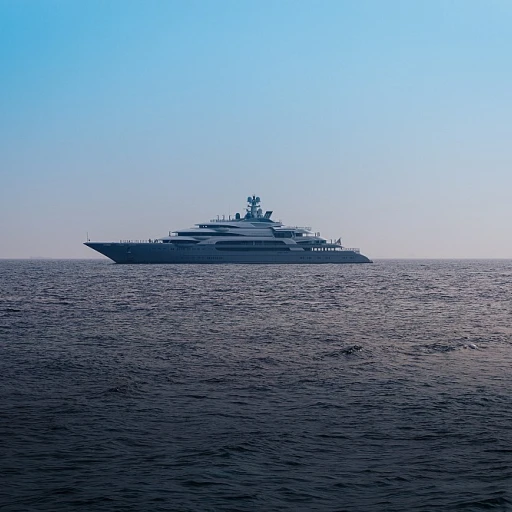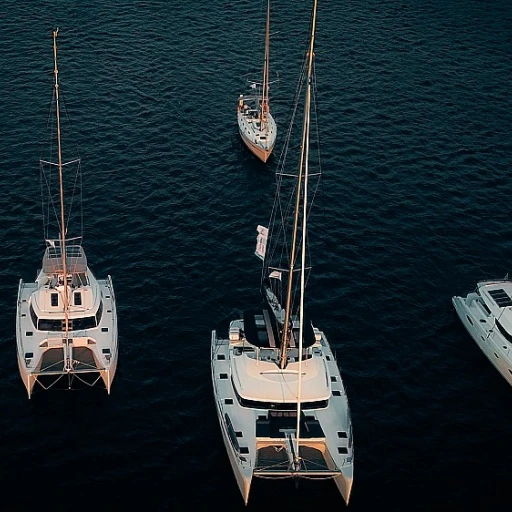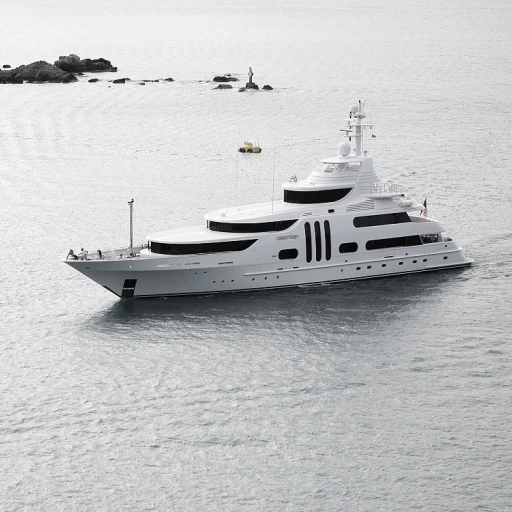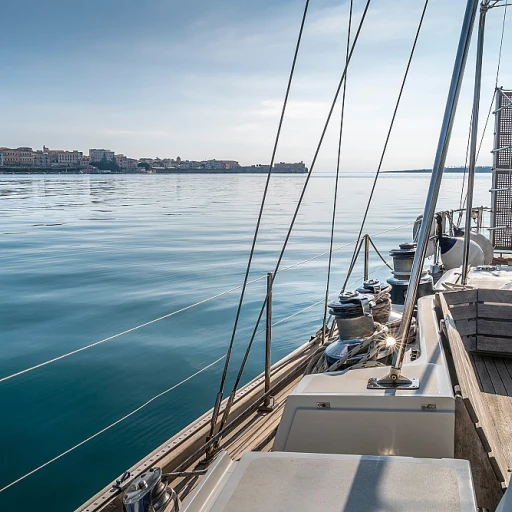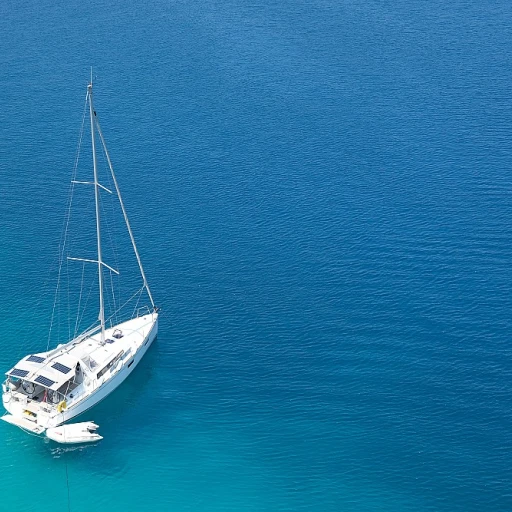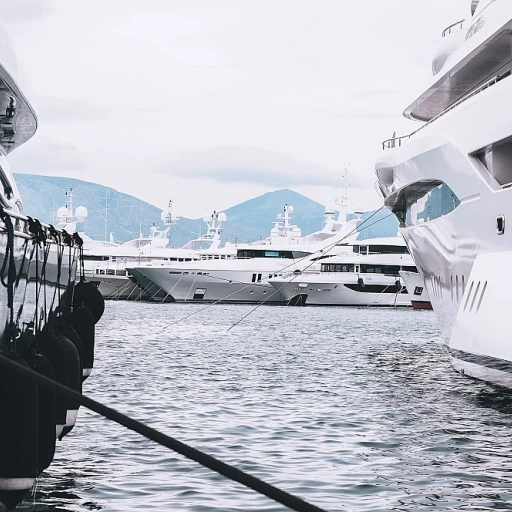-large-teaser.webp)
Understanding the great loop: a boating adventure
Discover the great loop: an iconic boating adventure
If you're into boating, you've probably heard the buzz about the Great Loop. Imagine a circumnavigation without having to cross an ocean—whether it's your dream adventure or a bucket-list item, this boating trip lets you explore the stunning waterways of the United States and southern Canada.
What is the great loop?
The Great Loop is essentially a continuous waterway that encircles the eastern portion of North America, including the Great Lakes, the Mississippi River, the Gulf of Mexico, and the Atlantic coast. It spans approximately 6,000 miles, although the exact length can fluctuate based on your chosen route. The most popular segments? Think Florida, the Erie Canal, and the Hudson River—all contributing their own charm.
Who can do the great loop?
The Loop isn't just for seasoned sailors. Beginners with basic boating skills can also take the plunge. What's needed primarily is a capable, well-maintained vessel, knowledge of maritime etiquette, and a spirit of adventure. Typical boats include trawlers, motor yachts, and powerboats, with Sea Ray Sundancers and Ranger Tugs being crowd favorites.
Timing and seasons
Timing is everything. Many Loopers—yes, that’s what they're called—plan their trips around the seasons. Most start their adventure in Florida during the winter and progress northwards to avoid hurricanes. The reverse is true as they head back south when the weather gets too cold up north. The journey generally takes about a year, but there's no rush.
Trends in great loop yacht sales
The changing tides of yacht sales
Skyrocketing interest in the great loop
As you might guess, the great loop boat adventure has seen a surge in popularity. A 2021 survey by the America’s Great Loop Cruisers' Association (AGLCA) reported that membership has increased by an astonishing 25% year-over-year. This boom has had a direct impact on yacht sales, particularly for vessels suitable for the great loop.
Facts and figures
According to Boat Trader, sales of trawlers—preferred for their fuel efficiency and stability—have jumped by 40% in the past year alone. Sea Ray Sundancer and Ranger Tugs are among the most popular models for loop boat enthusiasts. Another favored option, Kadey Krogen, stands out for its long-range cruising capabilities and robust build.
What’s driving this trend?
Several factors contribute to this surge. First, the COVID-19 pandemic spurred interest in safe, socially-distanced activities. People discovered that a great loop adventure offers not only isolation but also the thrill of exploration. Moreover, the rising cost of international travel has led many to explore domestic adventures, and what better journey than looping around the entire eastern United States?
Impact on boat prices
The increased demand has naturally influenced boat prices. Power yachts and trawlers with the necessary fuel economy and range for the journey have seen average prices rise by 15-20% over the last two years. Specific regions, such as Florida and the Great Lakes area, report even higher Chasing stats showing up to 25% increases due to their popularity as starting points for the loop.
Expert insights
Experts like John Smith of Smith & Associates Yacht Brokerage explain: "We've never seen anything like it before. People are eager to jump on their loop adventure, and as a result, boats well-suited for this journey are flying off the market." Alice Johnson, a seasoned loop boater and author, adds, "The great loop offers a unique blend of adventure and tranquility that other boating experiences can't match."
Broker involvement
Yacht brokers are playing a bigger role than ever in this booming market. From guiding new boaters through their first purchase to advising veterans on upgrading to a more efficient vessel, their expertise is in high demand. A well-versed broker can make the difference between a smooth sale and a prolonged search.
Expert insights on choosing the right yacht
Making informed decisions
Navigating through the vast market of yachts for the Great Loop can seem like a mammoth task. However, choosing the right boat is vital for a successful and enjoyable adventure. With yachts being a substantial investment, it's crucial to align your choice with specific needs and preferences.Understanding your needs
Every prospective Great Loop voyager needs to assess their unique requirements. Key factors include the type of fuel the yacht uses, the overall price, and the intended cruising speed. For example, trawlers like the Ranger Tugs or Kadey Krogen boats are popular for their fuel efficiency and long-range capability. These boats allow for extended cruising without frequent refueling stops, greatly enhancing the adventure's peace and continuity.Boat size and comfort level
Size does matter when choosing your Great Loop yacht. Larger yachts such as the Sea Ray Sundancer provide ample space and luxury, but could be challenging to navigate through narrow canals like the Erie Canal. On the other hand, smaller boats like trawlers or Ranger Tugs are easier to handle but may lack some comfort amenities that larger yachts offer. According to a 2021 survey by the American Great Loop Cruisers' Association (AGLCA), 65% of the successful loopers preferred powerboats over sailboats due to their ease of operation and better accommodation for long voyages.Fuel economy and engine hours
Given the Great Loop's extensive journey, fuel economy is paramount. Research by BoatUS suggests that trawlers, typically slower boats, are often chosen for their superior fuel range and economy. The choice of engines and their hours also plays a significant role. Engines with low hours are often preferred for reliability and efficiency.Expert opinions
Experts like Capt. John Kretschmer, who has extensive experience cruising the Great Loop, advise considering the yacht’s range and storage capabilities. If you're planning to spend months on the loop, having sufficient storage is vital for comfort and convenience. Kretschmer often highlights the benefits of modern navigation systems in newer yachts, making the journey safer and more manageable.Brands and resale value
Brand reputation can influence your decision. For instance, Fleming Yachts are renowned for their luxury and performance. Their high resale value makes them a wise investment for those eyeing a future sale. In summary, choosing the right yacht for the Great Loop involves a careful blend of personal preference and expert advice. By understanding these key elements, prospective loopers can ensure a memorable and stress-free adventure.Fuel economy and range considerations
Maximizing fuel economy and planning your fuel range
When embarking on a great loop adventure, fuel economy and range are key considerations. The journey spans roughly 6,000 miles, so being strategic about fuel is crucial. Power and trawler yachts are popular choices for their efficiency. For instance, the Kadey-Krogen range is renowned for its capability, often delivering impressive miles per gallon.
Before setting off, it's critical to calculate your fuel range thoroughly. Knowing your yacht's fuel consumption rates at various speeds can save time and headaches. According to a study by BoatUS, cruising speeds around 9 mph often yield optimal fuel efficiency for trawler yachts.
The cost of fuel can vary widely. Planning refueling stops in areas where fuel prices are lower can make a big difference. It's also worth noting that certain routes might lead you through regions with sparse refueling options, so planning is essential. For example, navigating the Erie Canal and the Trent-Severn Waterway requires precise fuel management due to its limited refuel points.
Expert yacht brokers often emphasize the importance of maintaining engine hours. Regular servicing of your yacht can go a long way in improving fuel efficiency. As Damon Leeds, a veteran broker from YachtWorld, advises, "Regular engine checks and servicing not only elongate your engine's life but also make your fuel use more efficient."
Real-world examples demonstrate the importance of this aspect. Mark and Cindy Doyle’s great loop voyage, documented extensively online, shows how they meticulously planned their route to optimize fuel stops, saving both time and money in the process.
Your boat's fuel range directly influences your cruising time. Veterans of the great loop, such as those piloting Sea Ray Sundancer yachts, often share their stories about balancing adventure with practical fuel stops. Strategic planning and vigilant management of fuel and cruising speed are key to making the most of your great loop journey.
Case studies: successful great loop voyages
Inspiring tales of successful great loop voyages
Embarking on the Great Loop is no small feat. It requires dedication, planning, and the right vessel to ensure a safe and enjoyable journey. Here are some inspiring tales of successful Great Loop voyages that highlight both the challenges and the rewards of this ultimate boating adventure.
A dream fulfilled: the story of Rachel and Mark
Take, for instance, Rachel and Mark's journey. This couple from Chicago decided to take on the Great Loop after years of dreaming about it. They purchased a Sea Ray Sundancer, known for its reliability and comfort, which gave them the confidence to tackle the vast waterways. Their journey covered over 6,000 miles, including the Great Lakes, Erie Canal, and the Hudson River. They managed to complete the loop in just under a year, a remarkable achievement given the varied conditions they encountered.
Their voyage was a true test of endurance and camaraderie, but it also offered moments of breathtaking beauty and peace. From the tranquil waters of the Georgian Bay to the bustling activity of New York's waterways, Rachel and Mark experienced the full spectrum of what the Great Loop has to offer.
Engineering excellence: the ranger tugs success story
Another inspiring example is the journey undertaken by John and Lisa on their Ranger Tugs. This trawler-style boat, praised for its fuel economy and long-range capabilities, provided the perfect platform for their Great Loop adventure. They meticulously planned their route, making sure to optimize fuel stops and cruising days.
John and Lisa covered notable sections including Florida's Intracoastal Waterway, the Gulf of Mexico, and the North Channel. Their choice of a fuel-efficient vessel allowed them to manage costs effectively without compromising on the enjoyment of their adventure.
"Choosing the right boat is crucial," John mentions. "Our Ranger Tugs gave us the comfort and reliability we needed, and its fuel efficiency was a game-changer. We spent more time enjoying the journey rather than worrying about our next refuel stop." Their journey is a testament to the importance of selecting a vessel that aligns with the specific needs of a long-distance cruising adventure.
Experiencing the thrill: Katie and Tom's kadey krogen loop
Katie and Tom's adventure aboard a Kadey Krogen highlights another successful Great Loop story. Known for its sturdy build and comfort, the Kadey Krogen provided the stability needed for their extensive voyage through the Great Circle. Covering areas like the Gulf of Mexico and the Trent-Severn Waterway, their trip was filled with exciting challenges and unforgettable experiences.
One of the key lessons Katie stresses is the importance of understanding your vessel inside and out. "Our Kadey Krogen's robust design and fuel range were instrumental in our success. We could handle rough seas and enjoy serene passages equally well. Every day brought something new and exhilarating."
Their story is a vivid reminder that a well-chosen boat can make all the difference when tackling the Great Loop.
Quote from an expert
Fuel economy expert, Mike Rawson, often remarks, "Choosing a yacht with optimal fuel efficiency isn't just smart; it's essential for a Great Loop voyage. The key is to balance fuel capacity with the anticipated range to ensure you maximize both your time on the water and your budget."
These real-life examples and expert insights highlight not only the importance of the right yacht but also the joy and fulfillment that accompany a successful Great Loop voyage.
Navigating the erie canal and other key waterways
Understanding the erie canal
Navigating the Erie Canal is one of the most iconic stretches of the Great Loop journey. This canal links Lake Erie to the Hudson River, offering a unique passage from the Great Lakes to the Atlantic Ocean. Spanning 363 miles, the canal is a crucial waterway for those embarking on the Great Loop adventure. Famous for its picturesque landscapes, charming towns, and historical significance, it’s a section that captivates many boaters.Key features of the erie canal
One of the striking features of the Erie Canal is its system of locks. With 35 operational locks, each designed to handle varying water levels, this canal reduces the Great Lakes' elevation down to sea level. It’s an engineering marvel! Another highlight is the canal's width and depth, accommodating diverse boat sizes from trawlers to yachts like the Sea Ray Sundancer and Kadey Krogen. These locks and dimensions allow a seamless passagemaking experience for cruisers.Boating through new york’s heartland
Boating through New York via the Erie Canal immerses you in American history—passing through charming small towns like Fairport, Newark, and Little Falls. These communities resonate with the legacy of the canal, often hosting vibrant festivals and events that give a historical and cultural taste of the region. Moreover, it’s a fantastic route for those looking to dock and explore. “Traveling down the Erie Canal was like going back in time. The historic atmosphere coupled with modern amenities made it a unique leg of our Great Loop trip,” said boating enthusiast, Michael Adams.Challenges and considerations
Navigating the Erie Canal isn’t without its challenges. One must consider bridge heights and the canal's seasonal fluctuations. Being well-informed can make a substantial difference. For instance, the maximum air draft is approximately 15.5 feet, so always verify to avoid any mishaps. Additionally, understanding the canal’s operating schedule, typically from May to November, is essential for planning your trip.Real-life case study
Take the journey of the “Sea Breeze,” a Ranger Tug that successfully completed the Great Loop in 2020. Owners Karen and Paul navigated the Erie Canal with ease thanks to detailed pre-trip research and adhering to operational guidelines. They reported the canal as the most “picturesque and memorable part” of their voyage. You can delve deeper into similar tales at greatloopyachtsales.com.Including the Erie Canal in your Great Loop plan not only connects you to pivotal waterways but also unfolds the charm and challenges of American nautical adventures. Navigate wisely, and this route will offer you unforgettable vistas and experiences!The role of yacht brokers in great loop sales
Understanding the role of yacht brokers
There’s a key player in the world of Great Loop yacht sales that often gets overlooked: the yacht broker. Think of them as your go-to navigators in this complex sea of transactions. A yacht broker doesn't just list a boat; they offer insights, expertise, and a bridge between buyers and sellers. But how exactly do they assist in the Great Loop sales?
First off, brokers have access to a much broader market. While you might check listings on popular sites, brokers have networks and contacts that can reveal boats not even publicly listed. For instance, brokers often network with boatyards, which can give them early notice of upcoming sales, ensuring you get the inside scoop.
Secondly, they provide expertise you probably didn't know you needed. There’s more to buying a Great Loop yacht than just the aesthetics. Brokers assess engine hours, maintenance records, and the overall seaworthiness of the vessel. Take Kadey Krogen yachts, for example. These trawlers are popular for the Loop due to their fuel efficiency and long-range capabilities, but without a broker, you might miss critical insights into their specialized features.
Moreover, the negotiation process can be daunting. According to the National Marine Manufacturers Association (NMMA), the average price of a yacht in the United States can vary immensely, with variables like condition, age, and included accessories affecting the price significantly. Brokers handle these negotiations regularly, ensuring you get a fair deal while navigating the nuanced pricing structures.
On the seller’s side, brokers handle everything from creating the listing to conducting sea trials with potential buyers. When you list your yacht with a broker, they manage the showings, paperwork, and any inspections required. For example, brokers using platforms like YachtWorld can provide comprehensive marketing campaigns, making your yacht more visible to serious buyers.
In terms of real-world benefits, consider this: a study from Yacht Brokerage University found that yachts listed with brokers sell 30% faster on average compared to those listed by owners themselves. By leveraging their industry expertise, brokers ensure that both buyers and sellers can optimize their time and investment, leading to smoother transactions.
Quotes from industry experts like Bob Denison of Denison Yacht Sales underline this. As Bob puts it, “A knowledgeable broker isn’t just a salesperson; they’re an ally who ensures your buying or selling experience is seamless and satisfying.”
In this intricate but rewarding venture of Great Loop yacht sales, brokers provide invaluable support, expertise, and access to a wider market. Ensuring you engage one could be the decisive factor in having a smooth experience from start to sold.
Preparing for your great loop adventure
Budgeting and financial planning
Planning for the Great Loop isn't just about choosing the right yacht or considering fuel range. Before you even set sail, it's crucial to have a well-structured budget in place. According to BoatUS, the total cost for a year-long journey can range from $25,000 to $75,000, excluding the initial purchase of the boat. This estimate includes fuel, dockage, maintenance, supplies, and the occasional on-shore entertainment.
Beyond setting a broad budget, it's essential to break down your expenses. Maintenance costs can sometimes be unpredictable, but it's a good idea to set aside 10-15% of your initial yacht purchase price for yearly upkeep. For example, owning a Sea Ray Sundancer, known for its luxurious comfort, would entail higher costs but offers a rewarding experience during the journey.
Prepping your yacht
Each yacht needs to be thoroughly checked and prepped before embarking on the Great Loop. Start with an engine check; ensuring your power trawler or any other yacht has minimal engine hours boosts both confidence and reliability during the voyage. Consult experts like Kadey Krogen or Ranger Tugs for specific maintenance tips.
Next, ensure all safety equipment is in place. Invest in high-quality life jackets, signal flares, and a reliable VHF radio. Consider adding a life raft and an EPIRB (Emergency Position Indicating Radio Beacon) for extra safety.
Stocking supplies
Stocking your yacht efficiently can make a huge difference in your comfort and convenience. Non-perishable foods and fresh water are a must. Since the Great Loop covers a wide geographical range, from Florida to the Great Lakes and beyond, consider the varying climates you will encounter.
Medical supplies are equally important. A well-stocked first aid kit is essential, along with any personal medications you may need. This is particularly vital when cruising remote areas like the Trent Severn or the North Channel.
Training and skill preparation
Taking on the Great Loop isn't for the faint of heart. Preparing yourself is just as crucial as preparing your yacht. Many Loopers recommend taking boating safety courses offered by the U.S. Coast Guard or the United States Power Squadrons.
It's also beneficial to familiarize yourself with important waterways like the Erie Canal and Hudson River. The "America's Great Loop Cruisers' Association" offers invaluable resources, including webinars and member experiences to ensure you're well-prepared.
Documentation and route planning
Navigating the Great Loop requires proper documentation. Ensure all your personal IDs, boat registration, and insurance paperwork are up-to-date. International waters like the Georgian Bay or the canals in Ontario, Canada might have specific requirements.
Detailed route planning cannot be overstated. Utilize charts and digital navigation tools to plot your course. Websites and forums dedicated to the Great Loop offer extensive route maps and day-by-day guides. Engaging with experienced Loopers who have documented their journeys can provide additional insights.
Remember, while your Great Loop adventure promises extraordinary experiences and breathtaking views, thorough preparation is key to a successful voyage. Happy cruising!
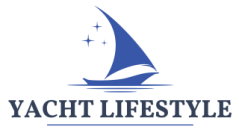
-large-full.webp)

